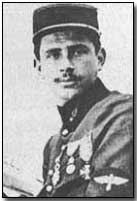Who's Who - Edmond Thieffry
 Edmond Thieffry (1892-1929) was
Belgium's third-highest scoring
air ace of
the First World War, with his ten victories placing him behind
Willy
Coppens' 37 and Andre de Meulemeester's 11.
Edmond Thieffry (1892-1929) was
Belgium's third-highest scoring
air ace of
the First World War, with his ten victories placing him behind
Willy
Coppens' 37 and Andre de Meulemeester's 11.
Thieffry, who was born in Etterbeek on 28 September 1892 and worked as a civil lawyer, was prompt in enlisting with the Belgian infantry with the arrival of war in Europe in in 1914. Unfortunately he was also quickly captured and taken prisoner by the invading German Army.
Nevertheless seizing his opportunity to escape - via a stolen motorcycle - he fled to neutral Netherlands where he was duly interned. Successfully arguing for his release he returned to Belgium, once again via his stolen German motorcycle.
July 1915 brought Thieffry a transfer to the Belgian Air Service in Etampe. He made a decidedly inauspicious start, crash-landing more aircraft during training than any other pilot before him. Such was Thieffry's disastrous record that his officers pronounced themselves reluctant to assign him to a two-seater squadron for fear of the risk to his fellow passenger.
Instead Thieffry was assigned to single-seater aircraft. Unfortunately his first flight - in a Nieuport Scout - resulted in a crash-landing and, while climbing from the wreckage, he inadvertently set off the aircraft's machine gun, causing some distress to nearby onlookers.
However Thieffry (known as the "The Flying Judge") was by no means the first successful fighter pilot who demonstrated greater skill at fighting than in flying. Between March and October 1917 he amassed a total of ten 'kills', thus qualifying as an ace. Brought down in flames in February 1918 he nevertheless survived both the accident and the war.
An early commercial pilot (and co-founder) for Belgian airline Sabena (with whom he flew from Brussels to Leopoldville in 51 days), Thieffry was killed while flying an aircraft in Africa on 11 April 1929. The recipient of the Belgian Order of Leopold II, he was aged 36 at his death.
French tanks were used for the first time in battle on 17 April 1917, when the 'Char Schneider' (as they were known) was used during the Second Battle of the Aisne.
- Did you know?
